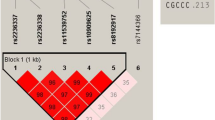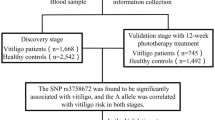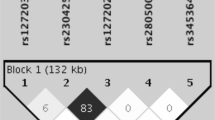Abstract
Vitiligo is an acquired hypomelanotic skin disorder resulting from the loss of functional melanocytes from the cutaneous epidermis and autoimmunity has been suggested to play a part in its pathogenesis. Recently, the missense R620W polymorphism in the PTPN22 gene, which encodes lymphoid protein tyrosine phosphatase (LYP), has been associated with susceptibility to autoimmune disorders. The objective of this study was to ascertain if the disease-associated 1858T allele was also associated with generalised (nonsegmental) vitiligo and so the frequencies of the PTPN22 1858C/T alleles were investigated in 165 English patients with generalised vitiligo and 304 ethnically matched control subjects. The results indicated that the 1858T allele was significantly over-represented in the vitiligo patient group compared with the control cohort. Of 330 vitiligo alleles, 48 (14.5%) encoded the Trp620 variant compared to 52 of 608 (8.6%) control alleles (P=0.006; odds ratio=1.82, 95% confidence interval=1.17–2.82). The results indicate that the LYP missense R620W polymorphism may have an influence on the development of generalised vitiligo and provide further evidence for autoimmunity as an aetiological factor with respect to this disease.
This is a preview of subscription content, access via your institution
Access options
Subscribe to this journal
Receive 6 digital issues and online access to articles
$119.00 per year
only $19.83 per issue
Buy this article
- Purchase on Springer Link
- Instant access to full article PDF
Prices may be subject to local taxes which are calculated during checkout
Similar content being viewed by others
References
Kemp EH, Waterman EA, Weetman AP . Autoimmune aspects of vitiligo. Autoimmunity 2001; 34: 65–77.
Ochi Y, DeGroot LJ . Vitiligo in Graves' disease. Ann Intern Med 1969; 71: 935–940.
Cui J, Arita Y, Bystryn J-C . Characterisation of vitiligo antigens. Pigment Cell Res 1995; 8: 53–59.
Song YH, Connor E, Li Y, Zorovich B, Balducci P, Maclaren N . The role of tyrosinase in autoimmune vitiligo. Lancet 1994; 344: 1049–1052.
Baharav E, Merimski O, Shoenfeld Y, Zigelman R, Gilbrund B, Yecheskel G . Tyrosinase as an autoantigen in patients with vitiligo. Clin Exp Immunol 1996; 105: 84–88.
Kemp EH, Gawkrodger DJ, MacNeil S, Watson PF, Weetman AP . Detection of tyrosinase autoantibodies in vitiligo patients using 35S-labelled recombinant human tyrosinase in a radioimmunoassay. J Invest Dermatol 1997; 109: 69–73.
Lang KS, Caroli CC, Muhm A et al. HLA-A2 restricted, melanocyte-specific CD8+ T lymphocytes detected in vitiligo patients are related to disease activity and are predominantly directed against MelanA/MART1. J Invest Dermatol 2001; 116: 891–897.
Ogg GS, Dunbar PR, Romero P, Chen J-L, Cerundolo V . High frequency of skin-homing melanocyte-specific cytotoxic T lymphocytes in autoimmune vitiligo. J Exp Med 1998; 188: 1203–1208.
Palermo B, Campanelli R, Garbelli S et al. Specific cytotoxic T lymphocyte responses against MelanA/MART1, tyrosinase and Gp100 in vitiligo by the use of major histocompatibility complex/peptide tetramers: the role of cellular immunity in the etiopathogenesis of vitiligo. J Invest Dermatol 2001; 117: 326–332.
Kemp EH, Ajjan RA, Waterman EA et al. Analysis of a cytotoxic T lymphocyte antigen-4 (CTLA-4) gene polymorphism in patients with vitiligo. Br J Dermatol 1999; 140: 73–78.
McCormack WT, Bradley CA, Kristensen DL, She JX . Genetics of vitiligo susceptibility: association studies of immune response genes. Pigment Cell Res 2001; 14: 231.
Blomhoff A, Kemp EH, Gawkrodger DJ et al. CTLA4 polymorphisms are associated with vitiligo in patients with concomitant autoimmune diseases. Pigment Cell Res 2005; 18: 55–58.
Alkhateeb A, Stetler GL, Old W et al. Mapping of an autoimmunity susceptibility locus (AIS1) to chromosome 1p31.3–p32.2. Hum Mol Genet 2001; 11: 661–667.
Fain PR, Gowan K, LaBerge GS et al. A genomewide screen for generalized vitiligo: confirmation of AIS1 on chromosome 1p31 and evidence for additional susceptibility loci. Am J Hum Genet 2003; 72: 1560–1564.
Spritz RA, Gowan K, Bennett DC, Fain PR . Novel vitiligo susceptibility loci on chromosomes 7 (ASI2) and 8 (ASI3), confirmation of SLEV1 on chromosome 17, and their roles in an autoimmune diathesis. Am J Hum Genet 2004; 74: 188–191.
Zamani M, Spaepen M, Sghar SS et al. Linkage and association of HLA class II genes with vitiligo in a Dutch population. Br J Dermatol 2001; 145: 90–94.
Tastan HB, Akak A, Orkunoglu FE, Arca E, Inal A . Association of HLA class I antigens and HLA class II alleles with vitiligo in a Turkish population. Pigment Cell Res 2004; 17: 181–184.
Bottini N, Musumeci L, Alonso A et al. A functional variant of lymphoid tyrosine phosphatase is associated with type I diabetes. Nat Genet 2004; 36: 337–338.
Smyth D, Cooper JD, Collins JE et al. Replication of an association between the lymphoid tyrosine phosphatase locus (LYP/PTPN22) with type 1 diabetes, and evidence for its role as a general autoimmunity locus. Diabetes 2004; 53: 3020–3023.
Onengut-Gumuscu S, Ewens KG, Spielman RS, Concannon P . A functional polymorphism (1858C/T) in the PTPN22 gene is linked and associated with type I diabetes in multiplex families. Genes Immun 2004; 5: 678–680.
Ladner MB, Bottini N, Valdes AM, Noble JA . Association of the single nucleotide polymorphism C1858T of the PTPN22 gene with type 1 diabetes. Hum Immunol 2005; 66: 60–64.
Velaga MR, Wilson V, Jennings CE et al. The codon 620 tryptophan allele of the lymphoid tyrosine phosphatase (LYP) gene is a major determinant of Graves' disease. J Clin Endocrinol Metab 2004; 89: 5862–5865.
Kyogoku C, Langefeld CD, Ortmann WA et al. Genetic association of the R620W polymorphism of protein tyrosine phosphatase PTPN22 with human SLE. Am J Hum Genet 2004; 75: 504–507.
Orozco G, Sanchez E, Gonzalez-Gay MA et al. Association of a functional single-nucleotide polymorphism of PTPN22, encoding lymphoid protein phosphatase, with rheumatoid arthritis and systemic lupus erythematosus. Arthritis Rheum 2005; 52: 219–224.
Begovich AB, Carlton VE, Honigberg LA et al. A missense single-nucleotide polymorphism in a gene encoding a protein tyrosine phosphatase (PTPN22) is associated with rheumatoid arthritis. Am J Hum Genet 2004; 75: 330–337.
Hill RJ, Zozulya S, Lu YL, Ward K, Gishizky M, Jallal B . The lymphoid protein tyrosine phosphatase Lyp interacts with the adaptor molecule Grb2 and functions as a negative regulator of T cell activation. Exp Hematol 2002; 30: 237–244.
Cloutier JF, Veillette A . Association of inhibitory tyrosine protein kinase p50csk with protein tyrosine phosphatase PEP in T cells and other hemopoietic cells. EMBO J 1996; 15: 4909–4918.
Palacios EH, Weiss A . Function of the Src-family kinases, Lck and Fyn in T-cell development and activation. Oncogene 2004; 23: 7990–8000.
Hasegawa K, Martin F, Huang G, Tumas D, Diehl L, Chan AC . PEST domain-enriched tyrosine phosphatase (PEP) regulation of effector/memory T cells. Science 2004; 303: 685–689.
Rosenberg SA, White DE . Vitiligo in patients with melanoma: normal tissue antigens can be targets for cancer immunotherapy. J Immunother Emphasis Tumor Immunol 1996; 19: 81–84.
Okamoto T, Irie RF, Fujii S et al. Anti-tyrosinase-related protein-2 immune response in vitiligo patients and melanoma patients receiving active-specific immunotherapy. J Invest Dermatol 1998; 111: 1034–1039.
Yee C, Thompson JA, Roche P et al. Melanocyte destruction after antigen-specific immunotherapy of melanoma: direct evidence of T cell-mediated vitiligo. J Exp Med 2000; 192: 1637–1644.
Overwijk WW, Lee DS, Surman DR et al. Vaccination with a recombinant vaccinia virus encoding a ‘self’ antigen induces autoimmune vitiligo and tumor cell destruction in mice: requirement for CD4(+) T lymphocytes. Proc Natl Acad Sci USA 1999; 96: 2982–2987.
Norris DA, Kissinger RM, Naughton GK, Bystryn J-C . Evidence for immunologic mechanisms in human vitiligo: patients' sera induce damage to human melanocytes in vitro by complement-mediated damage and antibody-dependent cellular cytotoxicity. J Invest Dermatol 1988; 90: 783–789.
Gilhar A, Zelickson B, Ulman Y, Etzioni A . In vivo destruction of melanocytes by the IgG fraction of serum from patients with vitiligo. J Invest Dermatol 1995; 105: 683–686.
Nagamine K, Peterson P, Scott HS et al. Positional cloning of the APECED gene. Nat Genet 1997; 17: 393–398.
Wandstrat A, Wakeland E . The genetics of complex autoimmune diseases: non-MHC susceptibility genes. Nat Immunol 2001; 2: 802–809.
Woolf B . On estimating the relation between blood group and disease. Ann Hum Genet 1955; 19: 251–253.
Author information
Authors and Affiliations
Corresponding author
Rights and permissions
About this article
Cite this article
Cantón, I., Akhtar, S., Gavalas, N. et al. A single-nucleotide polymorphism in the gene encoding lymphoid protein tyrosine phosphatase (PTPN22) confers susceptibility to generalised vitiligo. Genes Immun 6, 584–587 (2005). https://doi.org/10.1038/sj.gene.6364243
Received:
Revised:
Accepted:
Published:
Issue Date:
DOI: https://doi.org/10.1038/sj.gene.6364243
Keywords
This article is cited by
-
A comprehensive meta-analysis and prioritization study to identify vitiligo associated coding and non-coding SNV candidates using web-based bioinformatics tools
Scientific Reports (2022)
-
PTPN22 gene polymorphism in Egyptian females with non-segmental vitiligo
Comparative Clinical Pathology (2013)
-
The CTLA-4 +49 A/G, CT60 A/G and PTPN22 1858 C/T polymorphisms and susceptibility to vitiligo: a meta-analysis
Molecular Biology Reports (2013)
-
The association of lymphoid protein tyrosine phosphatase non-receptor 22 (PTPN22) gene polymorphism with Egyptian immune thrombocytopenic purpura
Comparative Clinical Pathology (2013)
-
Meta-analysis reveals an association of PTPN22 C1858T with autoimmune diseases, which depends on the localization of the affected tissue
Genes & Immunity (2012)



